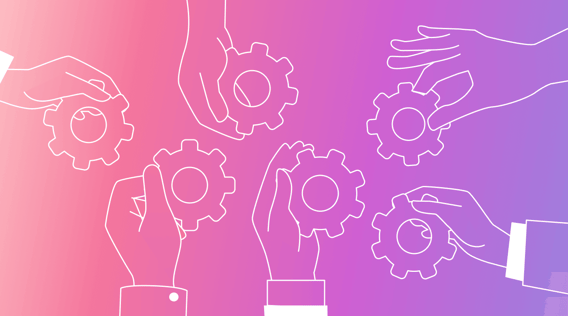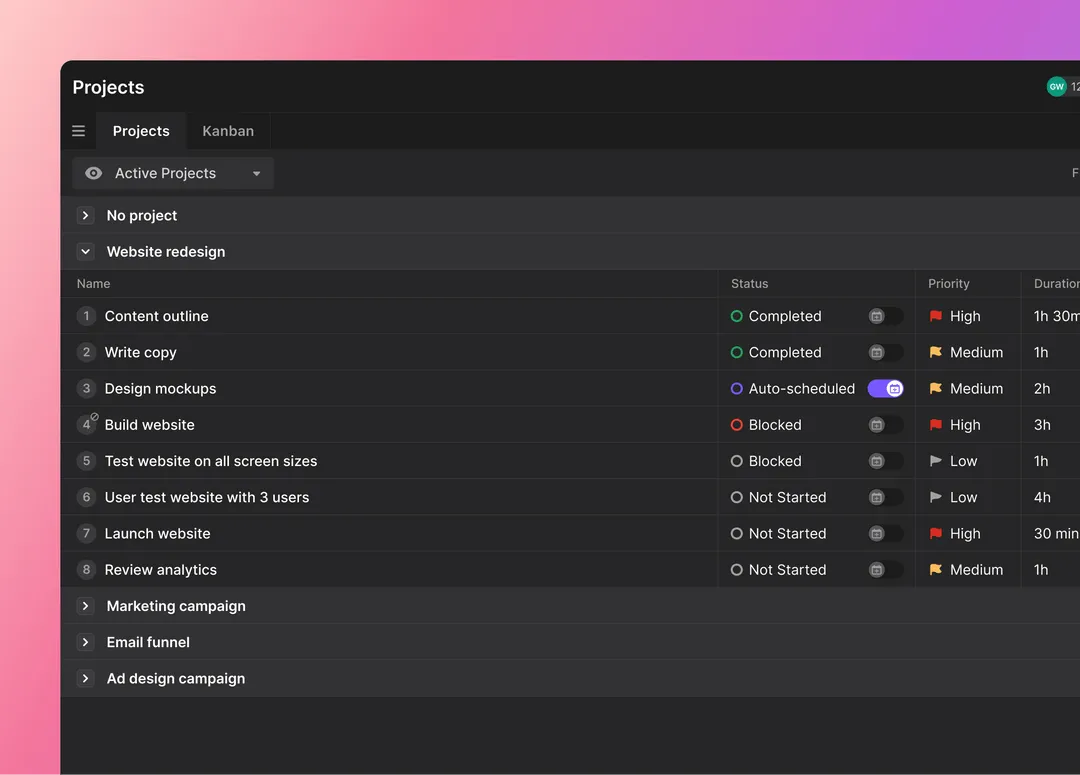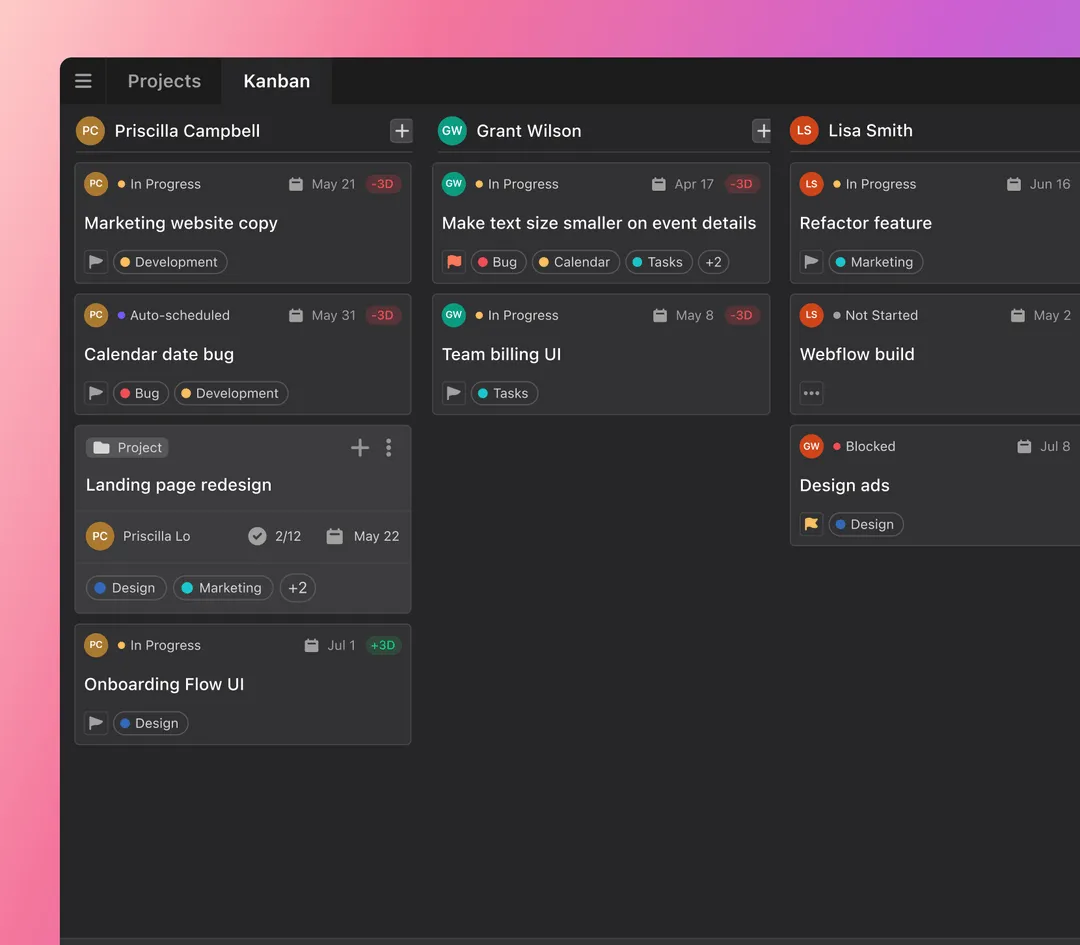Workplace collaboration doesn’t always come naturally.
Have you ever wondered why some team members work seamlessly together while others seem to constantly struggle to find common ground?
The reason isn’t necessarily personality clashes or people simply not getting along. It might be diverse work styles.
The reality is that not everyone has the same approach to work. Everyone has unique perspectives, preferences, and strengths, and those aren’t always going to align.
As a leader, it’s crucial to recognize the power of work styles in shaping team dynamics. When you understand everyone’s work style, you can draw on each person’s strengths and foster a more collaborative unit.
In the article, we dissect six work styles and help you uncover which ones best align with you and your team members so you can all reach your full potential.
What is a work style?
A work style is a personal approach or method of working. It’s about how you prefer to tackle tasks and what works best for you so you can accomplish your work effectively.
Everyone on your team might have a different work style. Some people thrive on structure and order, while others prefer a more flexible and creative approach.
Regardless of how each person works, understanding and embracing different work styles can lead to increased productivity and job satisfaction.
Why is understanding work styles important?
Imagine you’re a team leader with an important project on your hands and a team of diverse individuals. In an ideal scenario, everyone would work seamlessly together, using their strengths and collaborating to achieve goals.
Research shows that 49% of employees want more collaboration, but two out of three believe that their company won’t make changes in order to create a more collaborative environment.
By understanding personal work styles and looking for ways to foster a more unified workforce, you can live up to these expectations, improve collaboration, promote inclusivity, and optimize productivity.
Enhanced collaboration
The International Data Corporation (IDC) predicts that by 2024, companies with collaborative work environments will have 30% lower staff turnover, higher productivity, and higher revenue per employee.
Investing effort into understanding your team’s work styles will help you find common ground and unlock more effective ways to collaborate.
This will help you foster a culture of respect and appreciation, leading to improved outcomes and greater success for your team.
Cultivate inclusivity
Creating a culture of inclusivity, which the workforce is increasingly demanding, starts with workers understanding and learning each other’s work methods.
 |
Familiarizing ourselves with different approaches lets us accept and adapt to different perspectives and preferences. A more inclusive work environment promotes belongingness, strengthens team dynamics, and contributes to overall success.
Improved productivity
Once you have a clear idea about how your team works, you can tailor workflows and tasks to match each individual’s strengths and preferences.
Matching specific tasks with the unique strengths of each work style will maximize output and performance, bringing you closer to operational excellence.
6 work styles
Let’s take a look at six common work styles to better identify how your team works.
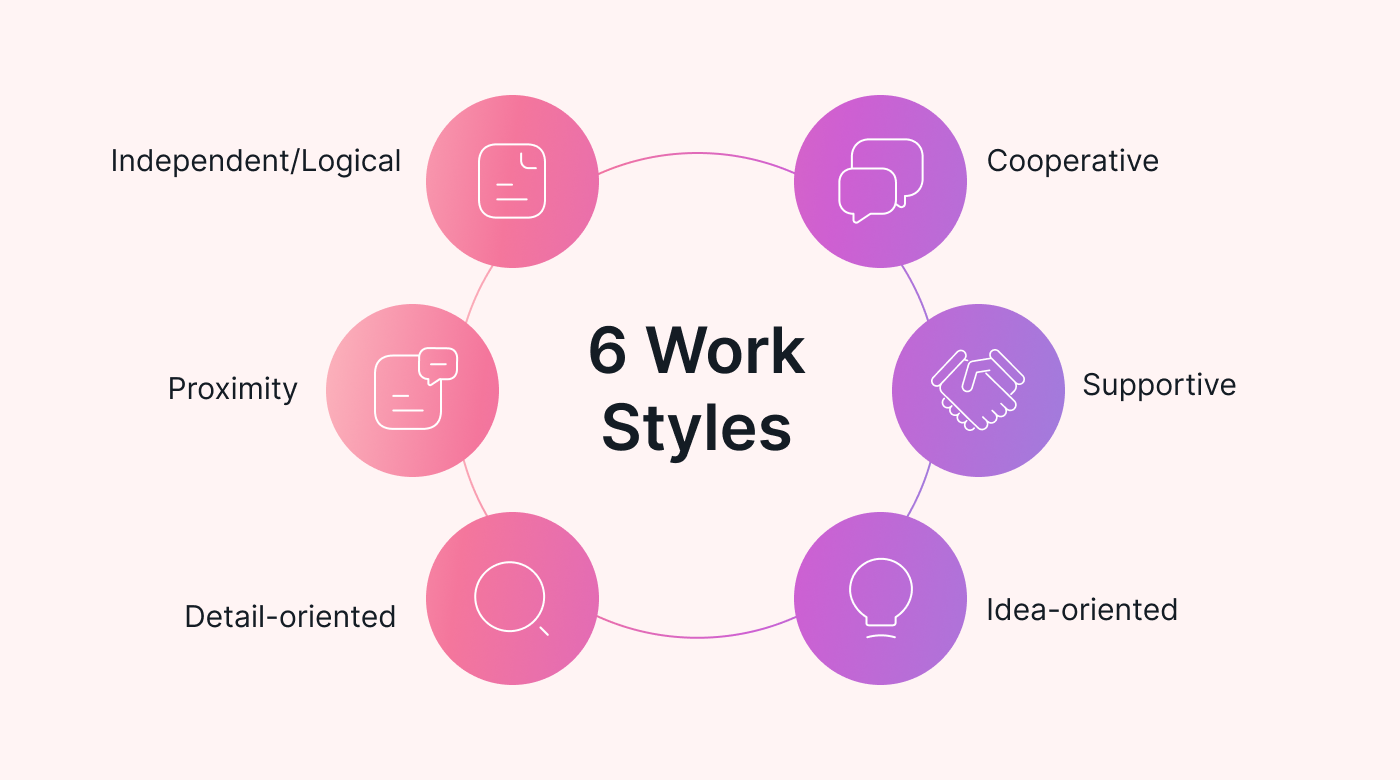 |
Independent/logical
The independent/logical worker is like a skilled architect, meticulously planning and constructing their work with precision. They’re self-reliant and prefer to navigate their work autonomously. With a strong reliance on logical thinking and rational decision-making, they strategically chart their course to accomplish their goals.
Work style example:
A software developer who prefers working alone on coding tasks and relies on data and evidence to make decisions.
Strengths:
- Completes tasks efficiently and independently
- Strong problem-solving and analytical skills
- Able to work well with minimal supervision
Weaknesses:
- Struggles with collaborative tasks and micromanagement
- Poor communication skills and limited perspective
- Difficulty adapting to sudden changes and unexpected situations
Cooperative
Cooperative individuals are often the “glue” that holds a team together. They thrive in group settings and value teamwork and consensus, and collaborating and actively engaging with others energizes them. Their ability to foster strong relationships and contribute to a collective effort makes them valuable team players.
Work style example:
A project manager who excels in collaborative environments, enjoys leading team discussions, and facilitates group decision-making to achieve project goals.
Strengths:
- Excellent team players
- Skilled at building relationships
- Open to diverse perspectives and ideas
Weaknesses:
- Slow decision-making
- Difficulty working independently and making individual decisions
- Lack ideas when working alone
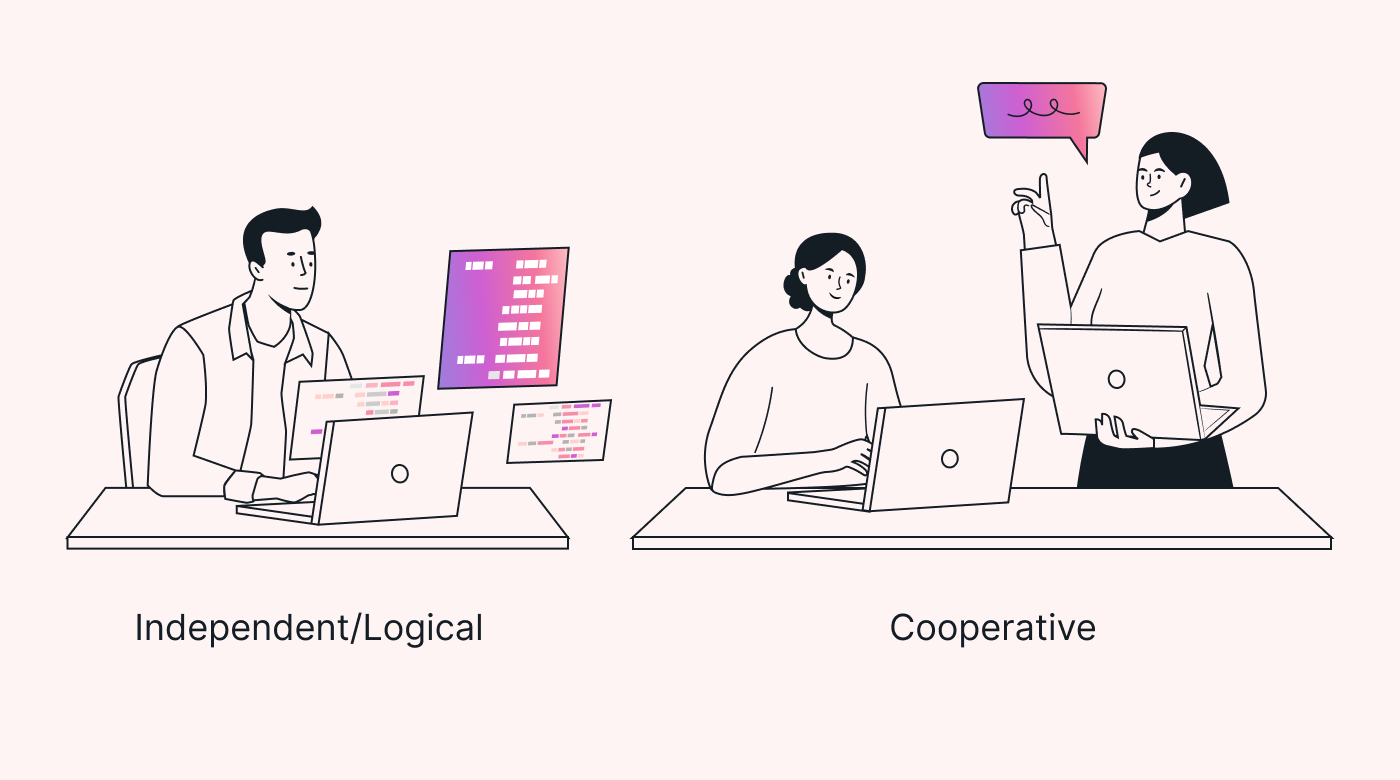 |
Proximity
Proximity-driven individuals value closeness and personal interaction. They prefer working in close physical proximity to their team members, appreciating face-to-face engagement.
While they can tackle tasks independently, they crave the immediate feedback and connection that comes from working closely with others.
Work style example:
A sales representative who likes prospecting alone but prefers in-person interactions and engaging with customers directly.
Strengths:
- Balanced between solo and collaborative work
- Quick to provide and receive feedback
- Strong ability to build rapport
Weaknesses:
- Struggles with remote or distributed work environments
- Distraction or noise may affect focus
- Dependent on immediate response
Supportive
Supportive individuals excel at creating a positive work environment, as they tend to prioritize helping others. They have a natural inclination toward providing emotional support and fostering teamwork. Their strengths lie in empathy, teamwork, encouragement, and creating an inclusive company culture.
Work style example:
A human resources coordinator who listens to employees’ concerns, provides emotional support, and organizes team-building activities.
Strengths:
- Excellent at fostering teamwork
- Adept at providing emotional support
- Strong listening and empathy skills
Weaknesses:
- Prioritizes others’ needs over personal work
- Difficulty asserting opinions and setting boundaries
- Tends to avoid conflict or confrontation
Detail-oriented
Detail-oriented individuals are known for their meticulous attention to detail. With a high standard and a keen eye for spotting errors, they ensure that tasks are completed with the utmost precision. They excel in roles that require careful analysis, organization, and a focus on the finer aspects of a project.
Work style example:
An accountant who triple-checks company finance records, diligently reviews numbers, and conducts comprehensive audits.
Strengths:
- Meticulous and thorough in their work
- Close attention to detail and accuracy
- Minimizes risks and errors
Weaknesses:
- Works at a slower pace
- Easily loses sight of the big picture
- Less inclined to take risks or embrace ambiguity
Idea-oriented
Idea-oriented individuals are the trailblazers of innovation, constantly pushing the boundaries and thinking outside the box. Their knack for unconventional thinking and imaginative problem-solving makes them the go-to person for tackling complex challenges. They get excited when exploring uncharted territories and bringing new possibilities to any team or project.
Work style example:
A marketing strategist who constantly generates innovative ideas to challenge traditional marketing approaches.
Strengths:
- Highly creative and fast thinkers
- Adaptable to change and emergencies
- Inspire large-scale change
Weaknesses:
- Difficulty implementing ideas
- Highly unstructured work style
- Impatient with routine or repetitive tasks
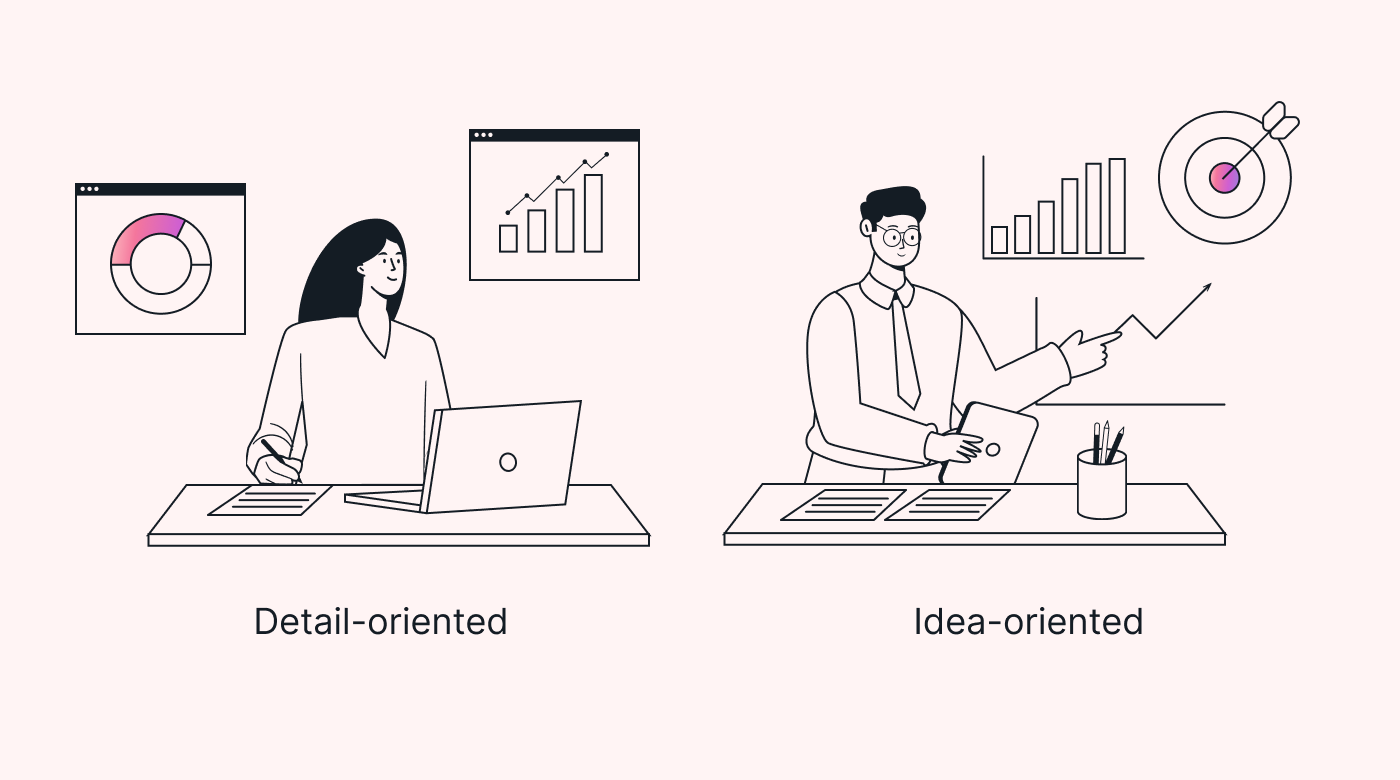 |
5 questions to ask yourself to find your work style
Discovering your and your team’s work styles is essential for fostering effective collaboration. Ask yourself these five key questions to better understand your work style:
1. How do I communicate?
Are you a passive listener or an active communicator? Reflect on whether you tend to listen more than speak or actively engage in discussions. Understanding your communication style will help you discover how you connect with others.
People with a logical work style may communicate via data-based arguments, while people with an idea-oriented work style may communicate through storytelling.
2. What is my role?
Consider the specific responsibilities and tasks you’re usually in charge of. Then, reflect on the parts of a team project that you naturally gravitate toward.
Employees with a detail-oriented work style may excel in roles that require meticulous attention to accuracy, such as quality control or data analysis. Cooperative individuals, on the other hand, may find themselves doing more collaborative tasks that involve teamwork, such as coordinating project timelines.
3. What kind of work engages me?
Are there specific tasks or projects that you especially enjoy doing? What makes you feel fulfilled in your job? Understanding the types of work that engage you is crucial for aligning your work style with your interests and strengths.
Someone with an independent/logical work style may enjoy tasks that involve solo problem-solving and strategic thinking. Proximity-driven individuals, on the other hand, may thrive in hands-on tasks that involve direct collaboration and immediate feedback, such as group problem-solving or interactive workshops.
4. How do I spend my workday?
When you have multiple projects or responsibilities to juggle, how do you plan your work week? Consider the amount of time you allocate for each task.
Are you someone who prefers structured schedules and time-blocking, or do you thrive with a more flexible and spontaneous work approach? Your time allocation habits can reveal information about your work style and how you manage your workload.
A detail-oriented teammate may rely on task lists, deadlines, and time management techniques like the Pomodoro Technique to plan their week. A cooperative teammate might spend more time setting up team meetings to evaluate progress and use project management tools to strengthen teamwork.
5. How do I approach conflicts?
Understanding how you approach conflicts provides insights into your work style because it influences how you handle disagreements, problem-solving, and collaboration with others. When you have a disagreement with a colleague, observe whether you avoid the conflict, seek a compromise, or assert your position.
 |
Supportive work styles prioritize maintaining relationships and resolving conflicts through open communication and active listening to find common ground. Idea-oriented work styles usually approach conflicts through open dialogue, too, but their focus may be on collaborative brainstorming to address the conflict in a different way.
Take a work style assessment test
The five questions above act as a guide to help you find your team’s work styles. However, if you want a more comprehensive understanding, you can also take a personality test, such as:
- The Myers-Briggs Type Indicator (MBTI) test
- The revised NEO Personality Inventory
- The SHL Occupational Personality Questionnaire
Tips for improving collaboration with people of different work styles
It’s natural for everyone on a team to have a different work style. And being able to accept, appreciate, and adapt to different approaches is the foundation of a cohesive and successful team.
Let’s get down to how you can bridge the gap between various work styles for better teamwork and productivity.
Identify your team’s work styles
Get to know your team’s work styles like you know your favorite TV characters. Take the time to understand each member’s unique approach to work, recognizing their preferences, strengths, and areas for growth.
You’ll be able to better align tasks and responsibilities, optimize collaboration, and create a high-functioning work environment for everyone.
You can use tools like Motion to track how much time everyone on your team spends on specific tasks. That way, you’ll have a clearer picture of their work patterns and be better able to identify areas where they excel or need support.
Pair tasks with strengths
Pairing tasks with strengths is a powerful strategy for maximizing productivity and engagement within your team.
Delegate tasks and projects that align with each employee’s capabilities and preferences so that work is assigned to the most suitable employees.
Motion’s automation intelligently delegates tasks to make managing your team’s workflow a breeze.
Manage each work style accordingly
Don’t expect to manage all your employees in one way. Instead, learn to adapt your management and leadership approach to accommodate different work styles.
According to MIT Sloan Management Review contributor Curtis L. Odom, leaders need to adapt to the workplace and provide the necessary resources and support for workers to reach their full potential.
With team members who are independent or detail-oriented, set a meeting time and prepare your case. Provide data-backed evidence, and make sure you follow through when you agree to something.
Cooperative and supportive team members tend to respond better to softer and more intimate approaches. It’s important to communicate openly with them and show appreciation for their contributions.
You can approach a worker who prefers a proximity work style face-to-face, provide immediate feedback, and give them opportunities for autonomy and decision-making within their role.
Since idea-oriented workers value innovation and creativity, encourage them to brainstorm and offer flexibility in their approach to problem-solving. Setting clear goals and deadlines can help them stay focused and organized.
You can also use Motion to help you keep track of project progress and team schedules to more effectively tailor your guidance approach.
Foster respect by building connections
Encourage your team to understand and appreciate each other’s work styles, as this not only strengthens work relationships but also promotes mutual respect.
A good way to help different work styles connect and collaborate is to establish effective communication channels for feedback, idea sharing, and collaboration. Eighty percent of workers prefer immediate feedback, which highlights the importance of providing timely input and support.
Motion helps you create an employee feedback system for real-time feedback, which enhances collaboration and productivity across different work styles. Fostering open communication, understanding, and appreciation of diverse work methods leads to a supportive and productive team with members who complement each other.
Motion empowers all work styles to work better together
Managing people isn’t easy, but with the right management methods and tools, you can bridge the gap between different work styles and build a collaborative and productive A-team.
Motion provides the necessary support for managing diverse workers with features like automated task allocation, progress tracking, and instant communication channels.
We want to help you cultivate a work environment where different work styles are understood, respected, and optimized for collective success.
So take the next step and empower your team with Motion today.

